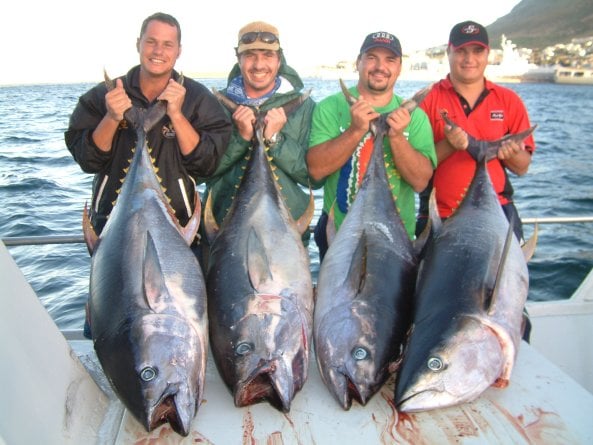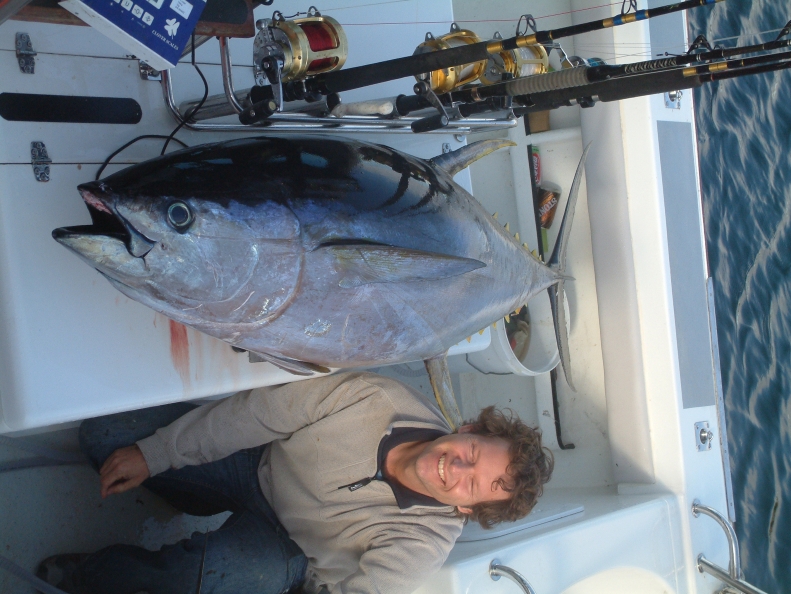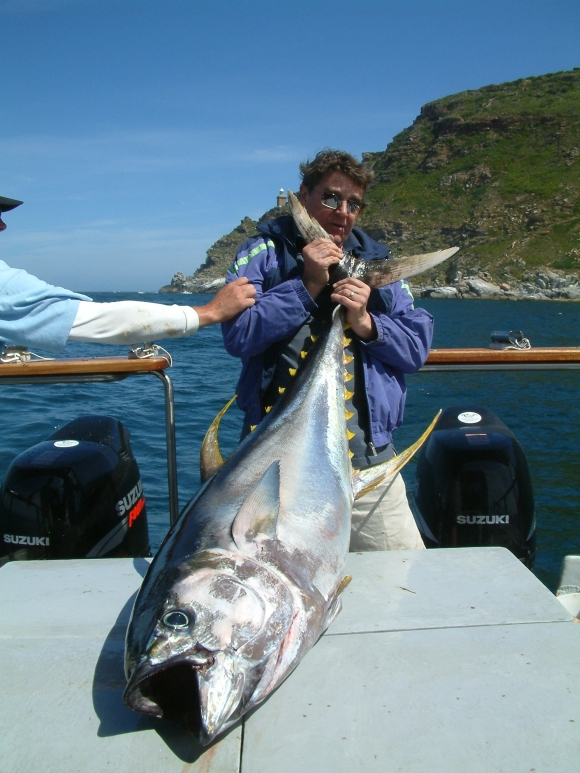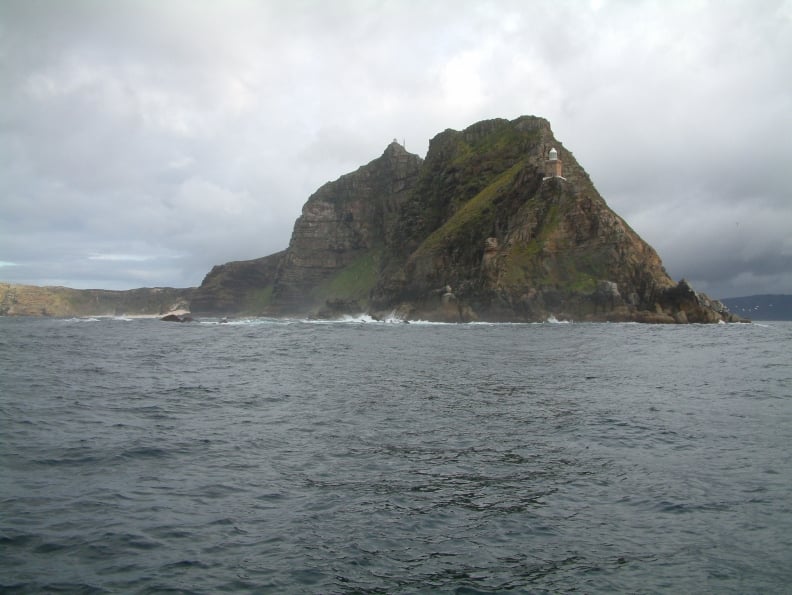FOR TODAY
FOR TODAY
Two Oceans Sports Fishing Overview
The Tuna Fishing Charters are well renowned as one of the top tuna fishing locations in Cape Town. The team provides a top-quality service combined with a deeply ingrained passion for fishing that spans over 18 years of fishing experience.
They are also the only fishing charter company within South Africa to have landed three yellowfin tuna weighing 100kg in one season and boast some of the biggest tuna caught on a rod in South Africa.
Based in Hout Bay and offer great fishing trips in the bay in search of yellowtail and snoek as well as offshore to catch the large yellowfin and longfin tuna. Two Oceans prides itself on a great catch record with a 95% success record.
The boats that run are surveyed annually and carry full safety equipment on-board at all times while radio contact is always maintained with the shore. Remember to always dress warmly and take sunscreen, sunglasses and a hat. Should you have less than the designated number of people per your charter, payment for the maximum number is still applicable. The trips are ideal for both novice fishermen and seasoned anglers as several different charter options are available, including the following:
Offshore Tuna Fishing
The Tuna trip requires a full charter of the boat based on 6 people. These charters are conducted offshore in Cape Town in search of yellowfin tuna with catches of between 50 and 80 kg being the norm. You can expect to depart for this trip between 6 and 7 am before travelling about 70 km by boat to the best tuna grounds with the return being around 4 pm. The tuna can be seen alongside the boat providing for a very exciting fishing excursion. Only the best tackle and rods are used on the trips and stand-up harnesses are available, allowing for an easier fight. Each catch is put on iced and is cleaned and filleted for you to take home. and clean and fillet fish for you to take home with you if you would like to as a courtesy service.
In my opinion, the yellowfin tuna we target off Cape Town is one of the strongest fighting fish in the sea. Few places in the world can compare with the quality of our fishery with multiple 50 to 80kg yellowfin tuna being the norm on a typical charter and with fish reaching over 110kgs. We use a couple of different techniques including trolling, chumming or chunking, vertical jigging and fly in combination with a spray bar to attract tuna to the boat.
A typical day out:
Departure times from Hout Bay vary from 6:30 to 7:30. We usually depart as close to first light as possible and then travel offshore up to 40 nautical miles, about 70km to the tuna grounds. We are in the know as to the tuna movements and where best to go to locate the tuna schools. The runout is usually about 90 minutes to 2 hours so we are normally fishing from about 8:30 depending on what time we left the harbour.
Our main target species are Yellowfin tuna and longfin tuna. Blue and mako sharks also sometimes take the lines, which we release as well as yellowtail and dorado which one can expect late in summer. A rare but possible catch late in summer is striped and black marlin which seem to be getting more and more prevalent off our coast each summer season.
We tease up schools of tuna right under the boat and you see them swimming around and taking the baited lines! This provides hectic and very exciting fishing with continuous multiple hookups being the norm.
We only use the best tackle available including Penn International and Shimano two speed reels, we even have a custom-built CALSTAR rod on a Penn International 80 for the trophy tuna. The tackle is well maintained to ensure peak performance. We fish Black Magic stand up harness and gimbal systems allowing one to move around our walk around boats following the bigger more stubborn yellowfin.
We ice your catch and clean and fillet fish for you to take home with you if you would like to as a courtesy service. We normally aim to be back in the harbour from about 4 pm, but this varies due to the sea and fishing conditions.
Inshore Yellowtail and Snoek Fishing
Many inshore yellowtail and snoek fishing charters are available. For half-day charters to Cape Point full use of the boat is required with a maximum of six people. In winter 3 hour Hout Bay charters are available for groups of three to six persons. For a more private option, two people can book out the Sea Cat for a half-day trip.
These charters track the schools of yellowtail and snoek along the coastline while during tuna season it is sometimes possible to catch these big beasts.
Hout Bay is centrally located to the best inshore fishing spots in Cape Town. We follow the schools of yellowtail and snoek as they move along the coast and fish the reefs from Robben Island in the north down to Cape Point and Rocky bank in the South. During the tuna season (April/May and October to mid-January) it is often also possible to catch yellowfin tuna and longfin tuna close to the coast if the conditions are right while targeting the smaller inshore species. Our biggest yellowfin taken so far inshore on light tackle gear is 67kgs.
Although we do catch both yellowtail and snoek while trolling the yellowtail are often found chasing baitfish on the surface and one can cast spinners at them with very good results. The snoek is most often taken mid water while drifting and jigging or spinning with multiple hookups being the norm. Both species are most often in big schools which can provide great action. We also catch both species on the fly. Inshore charters depart from Hout Bay between 7 am and 8 am and are normally back in the harbour around 2 pm to 3 pm. However, we are flexible and can fit in with your time requirements.
Fly Fishing Yellowfin and Longfin Tuna
The fly fishing charters are only available for groups of two people. This extreme fishing involves trying to catch the great yellowfin tuna on the fly. This type of charter attracts serious anglers from all over the world and is great for those experienced saltwater fishermen looking for the ultimate trophy catch. These tuna put up a great fight with sustained power and brute strength and Two Ocean's boat Obsession has successfully landed more trophy yellowfin tuna on board than any other boat in South Africa.
Yellowfin tuna on the fly has to be the ultimate challenge for any serious saltwater fly fisher and is what I like to call EXTREME fly fishing. Anglers from around the world have fished with us in pursuit of trophy yellowfin tuna on the fly. After landing yellowfin with us their opinions have been unanimous – they never expected the sustained power and brute strength that the yellowfin tuna are capable of.
Captain Dave’s personal best yellowfin tuna to date on a fly rod on a heavy tippet is 76 kg taken on a 14 weight SAGE. On 10 kg tippet (IGFA) his biggest yellowfin is 51.58kgs smashing the current world record of 46.8kgs! More trophy yellowfin tuna have been successfully landed on fly tackle onboard Obsession than any other boat in South Africa. Captain Dave is a world leader in catching big tuna on the fly. Let his experience assist you in landing your fish of a lifetime.
Fly Fishing Yellowtail and Snoek
Yellowtail can be caught on the fly both inshore and offshore in Cape Town. Snoek is known as the cape sailfish and is normally caught mid-water by drifting over the large schools.
Not to be confused with yellowfin tuna, yellowtail is caught on the fly both inshore and offshore. Inshore they hang around reefs and often chase schools of baitfish to the surface while offshore they tend to hang around current lines and underneath anything that has been floating for a while offshore such as a kelp raft or a buoy with some rope still attached that has broken off a ship.
Snoek knew as the “cape sailfish” are caught mid-water drifting over large schools and stripping a sinking line with a baitfish imitation fly attached. We generally target the yellowtail and snoek on 10 to 12 weight fly rods.
Tuna Spear Fishing
Bluewater spearing for yellowfin and longfin tuna off the Cape is becoming more and more popular. With large numbers of big yellowfin often present spears are at times spoilt for choice.
During the tuna season, offshore water conditions can be greener at times but often blue water moves in providing clean water and excellent visibility. Bluewater conditions are superb with water temperatures from 18 to 22 degrees C and under ideal conditions water visibility up to 25m.
We normally shoot with 1.4 double rubber aluminium barrel guns. The spears have detachable heads and the guns are rigged in a breakaway fashion. This breakaway is attached to about 20m of bungee cord which is in turn connected to professionally rigged locally made Tommie Botha tuna boogie boards.
Tuna are incredibly powerful fish and although it is not necessary to dive very deep to shoot them there is always the threat of blackout from being dragged under. Combined with this is the current and chance of encountering mako and blue sharks makes it important to be competent while in the water.
Because of this we only take competently experienced out to shoot tuna. We can supply two 1.4m guns as well as weight belts and boogie boards including bungee lines, cumbersome items one would not want to travel with. If you require more gear let us know in advance so we can see what we can arrange for you.
Pelagic Birdwatching
Two Oceans operate a unique pelagic birdwatching trip with years of local knowledge. The trip is available for groups of eight people and it goes offshore where a wide variety of seabird species can be seen in great numbers. The winter months are great for this type of trip where it is not uncommon to spot seven different Albatross species and more than 10 000 individual birds. These trips depart from Hout Bay and include an experienced guide, refreshments and a light lunch.
Being the first ski boat in Cape Town to offer Pelagic birding tours for Birding Africa and Cape Town Pelagics about 10 years ago now Two Oceans are by far the most experienced operator. With years of local knowledge, we can provide you with the best possible pelagic birding experience.
A trip offshore into the pelagic trawling zone is a life experience. Nowhere else in the world is it possible to see so many pelagic species in such vast numbers. During the winter months, it is not uncommon to see up to 10 000 or more birds on a trip and possibly up to 7 different species of Albatross including icon species such as the wandering and royal albatross.
The amazing abundance of pelagic seabirds off Cape Town is due to coastal upwelling which fuels primary production. During our summer months, southeasterly winds blow northwards up and along the west coast. This results in surface water along the coast being pushed offshore by the wind resulting in a gradient or water deficit along the coastline. Nutrient-rich Atlantic Ocean water upwells from depths of 300m to balance the deficit providing the engine driving the cold Benguela current. The nutrient-rich water provides the food source and fuels primary productivity that in turn supports large numbers of baitfish providing food for the pelagic birds.
Both our boats cruise comfortably at 20 to 25 knots and provide a quick ride out to the pelagic trawling zone. We are also strategically placed running from Hout Bay in that we can run straight out offshore and don’t have to detour 33 kilometres (one way) south to get around Cape Point before being able to head out like any boats based in False Bay which wastes time (easily 90 minutes in unnecessary additional travel time) in the day.
Pelagic birds congregate around trawlers and longliners as this is where they can find easy pickings in the form of scraps from the commercial fishing trawlers and longliners. Here they can be seen in their thousands. Many of the birds fly past almost within touching distance of the boat, affording unsurpassed photographic and birding opportunities.
Two Oceans are members of Cape Town Tourism. Obsession undergoes an annual survey by the South African Maritime Safety Authority and carries full safety equipment on board at all times. Radio contact is maintained with coastal radio stations and both our boats are equipped with radiotelephone as an additional safety measure allowing for a comfortable and safe trip. Booking a Pelagic Trip with us is an experience you will never forget!
Likely sightings on winter trips (May to September):
- Common albatross – shy, black-browed, Indian yellow nose, Atlantic yellow nose.
- Rare albatross - wandering, northern royal, southern royal, grey-headed.
- Petrels – white chinned, pintado, soft plumaged, spectacled (rare)
- Shearwaters – sooty, great.
- Other - northern and southern giant petrels, Antarctic fulmar (occasional), Wilsons Storm petrels, Antarctic prion, broad-billed prion (very rare), cape gannet, arctic and subantarctic skuas.
Likely sightings on summer trips (October to April):
- Common albatross – shy.
- Rare albatross - wandering, northern royal, southern royal, grey-headed, black-browed, Indian yellow nose, Atlantic yellow nose.
- Petrels – White-chinned, soft plumaged, spectacled (occasional), great winged
- Shearwaters – sooty, cory’s, Manx (rare), flesh-footed (rare)
- Storm-petrels – Wilsons, European, leach’s, black-bellied
- Skuas – arctic, subantarctic and pomarine
- Other –Sabine's gull, grey phalarope (rare).
We are available for a pelagic charter throughout the week or weekend. Please see our website for prescheduled trips from June to early October (peak time). We also do private boat bookings. Trips depart from Hout Bay and include an experienced guide, refreshments and a light lunch. Please remember to bring warm, waterproof clothing as well as sunscreen and a hat.
Crayfish
During the crayfish season, charters can be booked in search of the Westcoast Rock Lobster. These excursions are available for groups of three to six people.
The Boats
Both of our boats are locally manufactured walk around Magnums built by Two Oceans Marine and exceed current American and European boatbuilding safety standards (there are no building standards in SA for boats under 9m be warned). Both boats are surveyed annually by SAMSA and carry the required safety equipment on board at all times.
- Boat: 28 foot powered by twin 250hp 4 stroke Yamaha outboard engines. Ideal for 1 to 4 people she can accommodate a maximum of 6 people.
- Boat: 32 foot also powered by twin 250hp 4 stroke Yamaha outboard engines. Ideal for 1 to 8 people.







